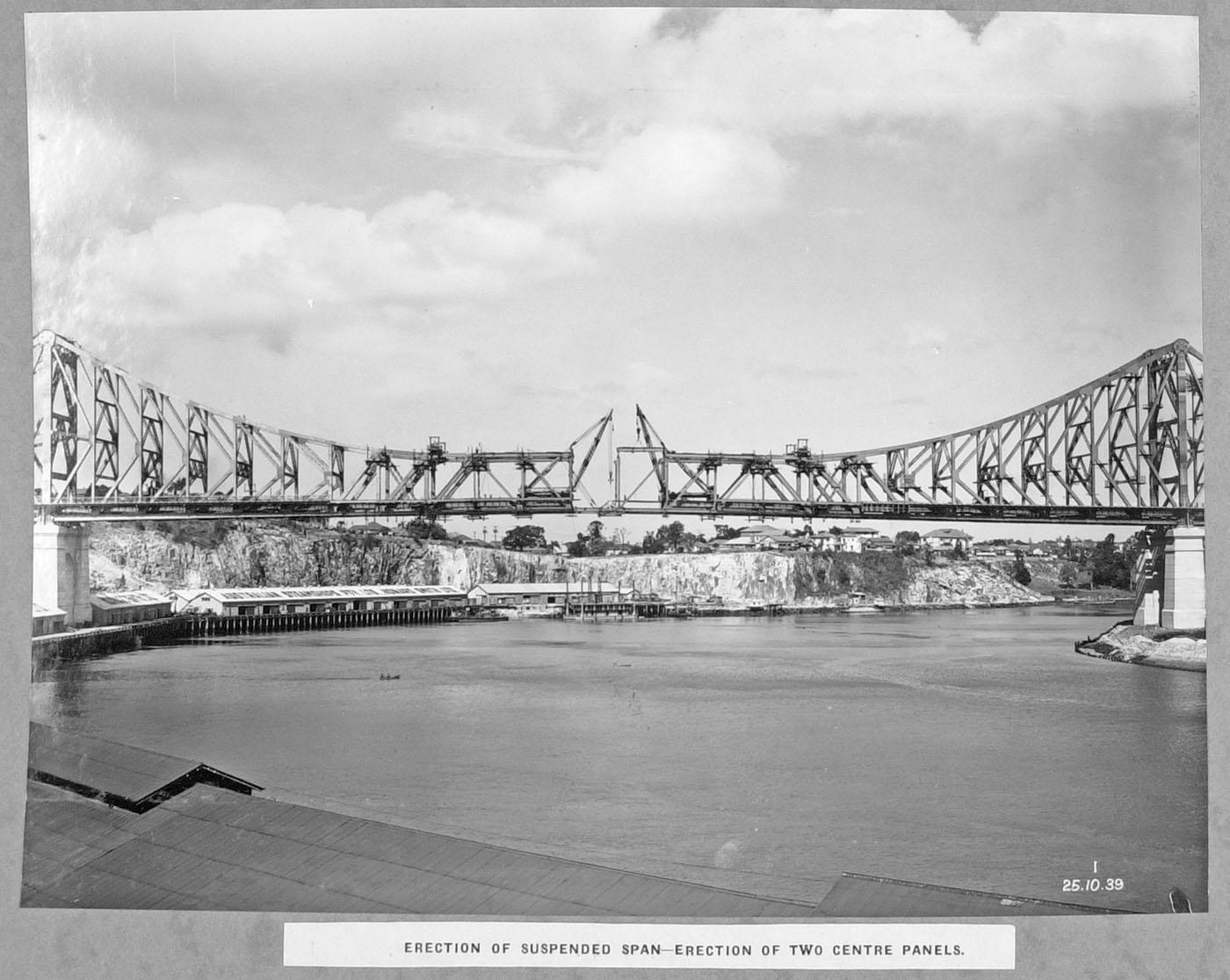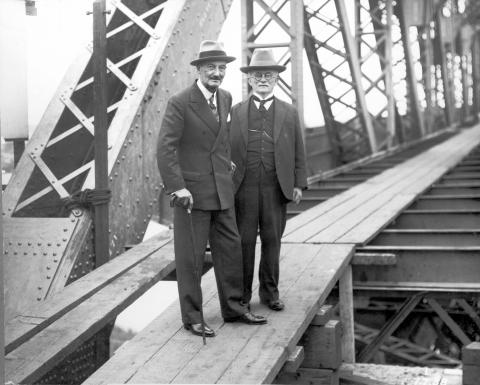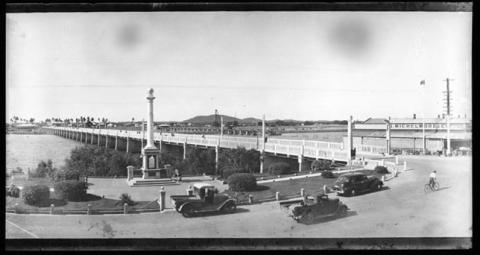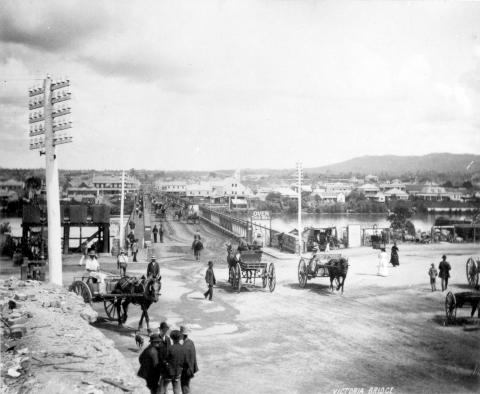
- News of the Day
-
Warwick Daily News, Thursday 14 December 1939, page 7
Story Bridge Tragedy
Drama On Narrow Plank
BRISBANE, Wednesday. — The drama enacted on a narrow plank at the Story Bridge construction when Arthur McKay Wharton, of Riverview, via Redbank, fell 100ft. to the river on December 6 was described by his workmate, Hermann Gerald Kleemeyer, of Woolloongabba, in the Coroner's Court to-day. Kleemeyer said that he and Wharton were riveting the bridge framework 450ft. from the Bowen Terrace end. Wharton, intending to work on three rivets about the level of his face, dropped a "holding up dolly" weighing 25lb.
"It seemed to strike him on the left knee, and after standing up he raised his trousers leg to have a look at the knee," said Kleemeyer. "Then he went to resume his seat on the plank. He was pale, and when he was about half-way to his original position he threw up his arms and went backwards into space.
"As he went back I called out, 'Oh, Mac!' and made a grab at him, but just touched his heel," continued Kleemeyer. "The sway frame between us hampered me and when I touched him the whole weight of my body was against me. If I had secured a good hold of him I might have gone over with him."
To the City Coroner (Mr. J. J. Leahy), Kleemeyer said that Wharton had complained of a small lump on his knee caused by falling from a horse. If anything touched the lump it gave him great pain. Kleemeyer thought the pain from the blow that morning made Wharton dizzy.
At the request of Sergeant P. H. Kinnane, the inquest was adjourned indefinitely.
- Background
-
This steel and concrete cantilevered bridge was constructed between 1935 and 1940 by contractors Evans Deakin-Hornibrook for the Queensland Government.
As early as January 1926 the Greater Brisbane Council's Cross River Commission had recommended the construction of a bridge at Kangaroo Point. Due to sectarian interests and prohibitive costs, however, the council chose instead to erect the Grey Street Bridge in 1929-32.
In 1933 the new Queensland Labor Government amended the Bureau of Industry Act, permitting the establishment of a Bridge Board chaired by JR Kemp, Commissioner for Main Roads, to plan a government-constructed toll bridge at Kangaroo Point.
Premature in terms of traffic requirements, the bridge was promoted as an employment-generating scheme. It was one of three such projects undertaken by the Queensland Government in the mid-1930s, the others being the Stanley River Dam and the University of Queensland campus at St Lucia.
Dr JCC Bradfield, designer of the Sydney Harbour Bridge, was appointed consulting engineer on 1 January 1934. He chose JA Holt as supervising engineer for the design of the bridge and supervision of the contract. Design and site surveys were undertaken in 1934.
Although modelled on the Montreal Harbour Bridge, completed in 1930, Bradfield emphasised that the grey steel elevation of the bridge was designed to harmonise with Brisbane's natural skyline.
Tenders for the Kangaroo Point Bridge were called in January 1935. The contract was let to Evans Deakin-Hornibrook Constructions Pty Ltd, with a price of £1,154,000, and construction commenced in May.
The Story Bridge remains the largest steel bridge designed and built mostly by Australians from Australian materials. Approximately 95 per cent of the materials used were of Australian manufacture, and 89 per cent of the cost of works was expended in Queensland.
All the steelwork, approximately 12,000 tonnes, was fabricated at the Rocklea workshop of Evans, Deakin & Co. Ltd. One truss of each type of approach span, and all joints of the main bridge, were assembled at the workshop then dismantled before removal, ensuring there were no difficulties in erecting the steelwork on site.
The concrete work and erection of the superstructure was carried out on site by the MR Hornibrook organisation.
The bridge was constructed simultaneously from both ends, with the main piers erected first. Excavations for the southern pier necessitated men working in watertight airlock chambers within steel caissons up to 40 metres below ground level. This was the deepest airlock work done in Australia at the time.
The approach spans were erected by a hammer-head crane operating along a runway. Then the anchor-cantilever trusses were erected in five stages using a 40 tonne derrick crane running on a temporary track on the bridge deck. Finally the bridge was closed using a system of wedge devices inserted in the top and bottom chords of each truss at the ends of the suspended span.
During 1938, which was the busiest period of construction, close to 400 persons were employed in the workshops, offices and on site.
From mid-1935 to 1940 the bridge was known as the Jubilee Bridge, honouring George V, but when opened on 6 July 1940 it was named after JD Story, the Public Service Commissioner and a member of the Bridge Board. The designer and the chairman of the Bridge Board were honoured in the naming of the southern approach viaduct as the Bradfield Highway and the northern approach as Kemp Place.
Although an engineering success, the bridge was regarded initially as a white elephant, the toll being unpopular and the traffic demand negligible. Not until the arrival of American troops in 1942 was the Story Bridge fully utilised. Nevertheless, the final cost of £1.6 million was recuperated within seven years, and in 1947 the bridge was transferred to the Brisbane City Council and the toll was removed.
The Story Bridge has become one of Brisbane's most widely recognised landmarks. Its illumination, carried out by SEQEB in time for the 1986 Warana festival, reflects its unique status as a symbol of the city.
Courtesy of the Queensland Heirtage Register
/153.0323427,-27.4638088,7/450x450@2x.png?access_token=pk.eyJ1IjoicXNhLWRpc2NvLXFsZCIsImEiOiJjamJmdTgyZXEyeWNjMnlxZm8xcmtieHgxIn0.lmT9J5tTPKGuuccQgCVSAg)



